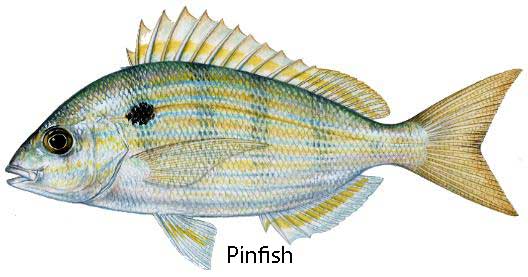
PINFISH

Lagodon rhomboids
English: Pinfish, Bream, Pin Perch, Sand Perch, Butterfish, Spanish Porgy
Spanish: sargo salema
Adults grow to around 4.5 inches (11.43 cm). Distinguishing characteristics include its olive back, bluish sides with yellow stripes and five to six vertical bars on sides. Pinfish have a silvery sheen overall, with yellow fins and a dark spot on the shoulder
An all around quality bait, almost any species that consumes small fish will eat a pinfish, though they can loose a percentage of their appeal during particular times of the year. In the fall when mullet are everywhere, or if there is an overabundance of whitebait in the area, most game fish will focus on the prevalent forage and more times than not, will ignore a struggling pinfish. Regardless, these baits really do glisten on both the inshore and offshore scene. Redfish, cobia, trout, snook, tarpon, snapper, grouper and big AJ’s all have pinfish on their menus.
When it comes to actually catching pins for bait, life couldn’t get much easier. As previously mentioned, put a tiny bit of squid on a #2 or #4 hook or even a sabiki rig and toss it over grassy bottom. It shouldn’t take long for you to occupy the well with a bunch of baits. To really make short work of the job at hand, chum the area for a few minutes and throw a cast net over the whole lot. A large mesh, heavy net which sinks quickly will do the job nicely as pinfish are quick and once spooked, will bolt out of there faster then the net can sink. Once captured, pinfish will feel right at home in your bait well. They’re extremely hardy and will often outlive all the other baits in your well.